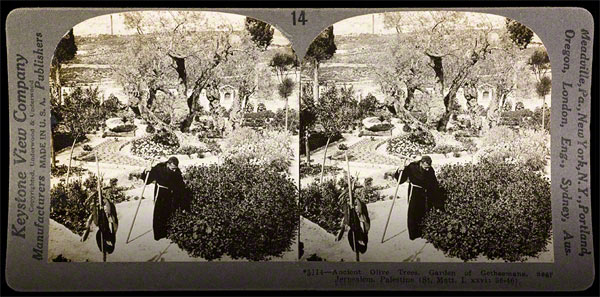Traveling the Holy Land through Stereoscope
A meld of optical technology and biblical scholarship, stereoscopic tours of the Holy Land plunged the viewer into a spiritually charged space simulated by a three-dimensional image. Stereo cards juxtaposed two photographs of the same scene from slightly different viewpoints corresponding to the distance between the eyes. When seen through the lenses of a stereoscope, the pair of two-dimensional pictures merged into a single three-dimensional scene. Detailed maps and extensive texts accompanied the boxed sets of stereo cards. The authors pointed out objects of interest, provided local color, and connected sites through scriptural citation.

Standing in the Very Presence of Palestine
Excerpts from Palestine through the Stereoscope, a tour conducted by Jesse Lyman Hurlbut and Charles Foster Kent (1914)
Have you dreamed of visiting Palestine? Have you longed to know what it would mean to stand by the wall of Jerusalem, in Nazareth? by the Jordan? You may now know, by the right use of the stereographs, specially devised maps and this book, what it is to stand in those very places...
Heretofore it has been possible only for the few, by an actual visit, to have the land made thus real to us, and indeed, the study of Palestine geography by means of maps and descriptions, as well as Bible History, has been left too much to the pastor's study and advanced classes...
Now for the first time, all may go beyond such study of Palestine as has been possible with ordinary maps and ordinary pictures and written descriptions. Now, if in conjunction with the specially devised maps in this book, we give ourselves up to the study of these parts of the Land, through the stereoscope, then in a true sense we may have experiences of standing in the very presence of Palestine. This "Fifth Gospel" has, in the past, been closed, practically, to the vast majority of believers. Now in a real sense it is possible for all to know what it means to stand in all the more important places throughout the land...
We have tried to serve as personal guides, saying everything in such a way as to constantly help and lead us to make this tour, to visit these places in the stereoscope, as a tourist visits the actual scenes in Palestine. It will be found that on this stereoscopic tour one is carried to all the more important places in Palestine, and in the same order as a tourist might visit them. In the more important sections the stereographed scenes are so connected that we may move from one position to another in such a way as to really make it a continuous journey. (p. xvi)
![]()
Here We End Our Pilgrimage
Excerpt from Hurlbut, Kent, and Hurlbut, Stereo tours of Palestine
Here fellow pilgrims, we end our journey. Together we came ashore on the strand of the sea at Jaffa and here at Damascus by the strand of the desert, we part. We have stood amid the hills of Judah, without the sepulchre of the patriarchs, and around the walls of Jerusalem. We have been together in the cave of the Nativity, and under the Dome of the Rock, and on the crown of Olivet. We have wandered beside Jordan, and over the Plain of Esdraelon, and over the Mountains of Galilee. We have seen the paths trodden by Abraham, and David, and Paul. We have seen battlefields where Joshua and Deborah and Gideon led the hosts. We have looked upon Elisha's spring and Jacob's well and Mary's fountain. We have stood under the trees in the Garden where our Lord suffered, have looked up to the mountains where he was transfigured, and on the green hill where he died. The paths of patriarchs and prophets and apostles we have seen; we have traveled throughout the land from Hebron to Hermon, and from the sea to the river; and here at Damascus...we end our Pilgrimage. (p. 203)